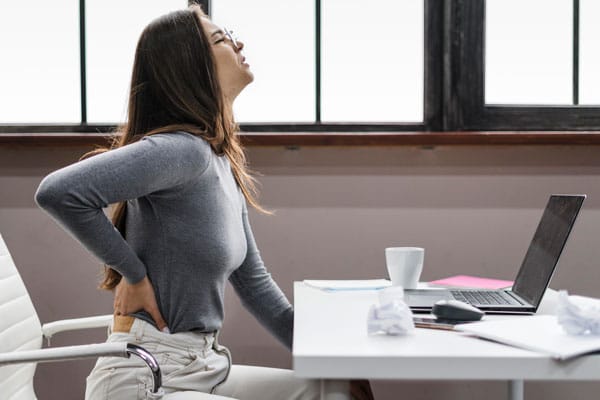
Does Prolonged Sitting Cause Back Pain?
Yes, prolonged sitting can cause back pain. Sitting for extended periods is a leading cause of discomfort and pain in the back, neck, arms, and legs. It places immense pressure on the spinal discs and muscles. Poor posture—like slouching—further stretches spinal ligaments and strains the discs, which can lead to chronic issues. Whether it’s lower back pain from sitting too long or neck pain from a poor workstation setup, the effects are felt by many.
Why Does Sitting Hurt Your Back?
Extended sitting can cause your back to stiffen, strain, or develop pain due to increased pressure on spinal discs and back muscles. When you sit for too long, the cushioning discs in your spine can begin to wear down, resulting in discomfort, especially in the lower back.
In fact, prolonged sitting is more stressful on your back than lying down. This sedentary habit has also been linked to metabolic issues, including obesity and high blood pressure. So, not only does sitting hurt your back, but it also impacts overall health.
Common Causes of Back Pain from Sitting
Poor Posture: Slouching or hunching increases pressure on the spine.
Ergonomic Issues: Non-adjustable chairs and poorly positioned desks can exacerbate strain.
Prolonged Sitting: Staying in one position for too long without adequate back support.
Health Conditions: Conditions like sciatica, herniated discs, or degenerative disc disease can worsen with sitting.
How to Prevent Back Pain from Sitting
Preventing back pain is easier than treating it. Incorporate these ergonomic and lifestyle changes to reduce strain:
1. Optimize Workplace Ergonomics
Elbow Alignment: Sit close to your desk with your upper arms parallel to your spine. Adjust your chair height so your elbows are at a 90-degree angle when using your keyboard.
Lower Back Support: Use a lumbar cushion or adjust your chair to maintain a slight arch in your lower back.
Eye-Level Screen Position: Ensure your computer screen is at eye level to avoid tilting your neck.
Calf Clearance Check: Sit with your back against the chair and check that you can slide your hand between your calf and the chair’s edge. Adjust the depth if needed.
2. Take Regular Breaks
No matter how ergonomic your setup is, prolonged sitting can still lead to stiffness and back pain. Stand up, stretch, or walk for 1-2 minutes every 30 minutes to keep your joints, ligaments, and muscles loose.
3. Adopt Proper Sitting Techniques
Sit with your buttocks fully against the back of the chair.
Keep your feet flat on the floor or use a footrest if needed.
Avoid slouching or leaning forward for extended periods.
4. Engage in Strengthening Exercises
Strengthening your core and back muscles can help provide better spinal support. Simple exercises like planks or stretching routines can be very effective in reducing pain from sitting.
Quick Fixes for Back Pain Relief
If you’re already experiencing back pain from sitting:
Apply ice or use a heating pad to reduce discomfort.
Try simple stretches like the Brugger relief position or hamstring stretches.
Use over-the-counter pain relievers or consult a physical therapist.
Key Takeaways
Can sitting cause back pain? Absolutely, prolonged sitting is one of the main reasons for lower back pain.
What are the symptoms of sitting too long? Stiffness, lower back pain, neck pain, and reduced flexibility.
How do you get rid of back pain from continuous sitting? Optimize your sitting posture, take regular breaks, and incorporate strengthening exercises.
The Bottom Line
Prolonged sitting is a leading contributor to back pain. By making simple ergonomic adjustments, maintaining good posture, and taking frequent breaks, you can significantly reduce the risk. If back pain persists, consult a specialist to rule out underlying conditions like sciatica or herniated discs. Small changes in your daily routine can lead to a pain-free and productive lifestyle.
Reviewed By

